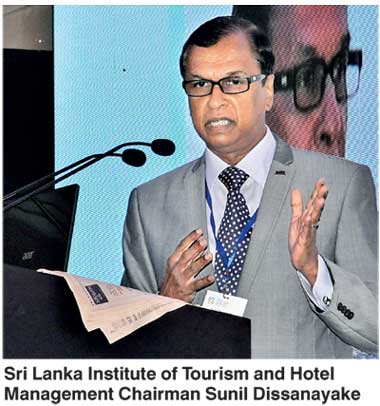Sunday Mar 16, 2025
Sunday Mar 16, 2025
Tuesday, 16 August 2016 00:04 - - {{hitsCtrl.values.hits}}
In a bid to convert the brain drain into brain gain and to make tourism-related employment more attractive, a top industry expert suggested the private sector include the service charge to the basic remuneration.
Addressing a session on the ‘Tourism Pillar,’ Sri Lanka Institute of Tourism and Hotel Management (SLITHM) Chairman Sunil Dissanayake proposed that hotels look at ways and means to include service charge into the basic pay of their employees in an effort to mitigate brain drain and as a measure to make the industry more lucrative to attract new entrants.
Noting that a minimum wage of a hotel employee is about Rs.13,000 to Rs.14,000, he asserted it was difficult to retain people at that level and it was unfair by the employees as they could not even apply for a bank loan for their personal commitments.
“It is obvious that people leave to the Middle East at this level of salary scale. We can only match the Middle Eastern salary by adding EPF and ETF, gratuity, and overtime calculated on the service charge,” he added.
Dissanayake was also critical about lack of real-time hard-core Learning and Development (L&D) for employees in the industry and at company level.
“Once they pass out from our school I do not know how much L&D they get in the industry. Very often we see in school how creative and talented these students are, but once they enter the industry, they are not given the opportunity as senior people stifle them. This is one of the main reasons forthe brain drain to Middle East,” he explained.
It was pointed out that since the dawn of peace there has been no significant investment in training and training budgets were generally the first to be cut. He also suggested welcoming retired professionals who have a wealth of experience to contribute to the development of the industry.
Mapping out the three-year strategic plan of SLITHM, Dissanayake said the institute would be in a position to deliver over 12,000 students by the end of next year, adding it would be even be able to meet up to 70% of the industry requirement with its rapid expansion plan of branching out to the suburbs.
As for the requirement of the industry headcount planning, SLITHM has carried out an analysis together with the National Human Resources Development Council and according to the findings as of end last year, 135,000 people had been in directemployment in the formal hotel and restaurant sector.
Dissanayake stated by the end of next year the industry would need 23,560 people for new jobs for the projects that are in the offing, while the total head count requirement by 2020 would add up to around 245,000 direct employment.
According to the breakdown of the 23,560 employment opportunities, 85% are at operator level, 10% at supervisory level and 5% at managerial level.
In addition to the various apprenticeship programs and awareness programs islandwide, SLITHM is looking forward to linking up with the National Youth Council (NYC) that produces about 15,000 soft-skilled people a year, who are left out with no connections or industry exposure.
Discover Kapruka, the leading online shopping platform in Sri Lanka, where you can conveniently send Gifts and Flowers to your loved ones for any event including Valentine ’s Day. Explore a wide range of popular Shopping Categories on Kapruka, including Toys, Groceries, Electronics, Birthday Cakes, Fruits, Chocolates, Flower Bouquets, Clothing, Watches, Lingerie, Gift Sets and Jewellery. Also if you’re interested in selling with Kapruka, Partner Central by Kapruka is the best solution to start with. Moreover, through Kapruka Global Shop, you can also enjoy the convenience of purchasing products from renowned platforms like Amazon and eBay and have them delivered to Sri Lanka.
Discover Kapruka, the leading online shopping platform in Sri Lanka, where you can conveniently send Gifts and Flowers to your loved ones for any event including Valentine ’s Day. Explore a wide range of popular Shopping Categories on Kapruka, including Toys, Groceries, Electronics, Birthday Cakes, Fruits, Chocolates, Flower Bouquets, Clothing, Watches, Lingerie, Gift Sets and Jewellery. Also if you’re interested in selling with Kapruka, Partner Central by Kapruka is the best solution to start with. Moreover, through Kapruka Global Shop, you can also enjoy the convenience of purchasing products from renowned platforms like Amazon and eBay and have them delivered to Sri Lanka.